City Island, Bronx
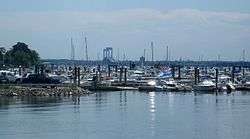 Looking southwest at marina and distant Throgs Neck Bridge | |
| Geography | |
|---|---|
| Location | Long Island Sound |
| Coordinates | 40°50′53″N 73°47′10″W / 40.848°N 73.786°WCoordinates: 40°50′53″N 73°47′10″W / 40.848°N 73.786°W |
| Archipelago | The Pelham Islands |
| Area | 0.39505 sq mi (1.0232 km2) |
| Length | 1.5 mi (2.4 km) |
| Width | 0.5 mi (0.8 km) |
| Administration | |
| State |
|
| City |
|
| Borough |
|
| Community District | The Bronx 10[1] |
| Demographics | |
| Population | 4,387[2] (2010) |
| Pop. density | 11,441.6 /sq mi (4,417.63 /km2) |
| Additional information | |
| Official website |
www |
City Island is a small island and a neighborhood approximately 1.5 miles (2.4 km) long[3] by 0.5 miles (0.80 km) wide. At one time it was incorporated within the boundaries of Pelham, Westchester County, New York, but it is now part of the New York City borough of the Bronx.
As of the 2010 census the island had a population of 4,362.[3][4] Its land area is 1.023 km2 (0.395 sq mi, or 252.835 acres). The island is part of Bronx Community District 10. City Island's ZIP Code is 10464, and it falls under telephone area codes 718, 347, and 929.
City Island is located at the extreme western end of Long Island Sound,[3] south of Pelham Bay and east of Eastchester Bay. The body of water between City Island and the even smaller (and uninhabited) Hart Island to the east is known as City Island Harbor. The small island adjacent to the northeast is High Island. The Stepping Stones Light, marking the main shipping channel into New York, is off the southern tip of City Island, near the Long Island shore. City Island is part of the Pelham Islands, a group of islands that once belonged to Thomas Pell.
History
.jpg)
Originally inhabited by the Siwanoy band of Lenape Indians, City Island later was settled by Europeans as part of property and estate bought by English nobleman Thomas Pell in 1654.[5] Prior to that, English settlers led by Anne Hutchinson (seeking religious freedom) settled in an area nearby on the river (now known as the Hutchinson River) in 1642. After changing hands several times, in 1761 the Island (at that time known as Minefer's Island), was bought by Benjamin Palmer of New York. Up to this point the island had been inhabited by only a few homes and farms. It had a population of about 1000 people, who tended farms and livestock. Palmer had the vision of developing the island into a port, which could rival that of New York. He knew that ships heading north and south passed City Island using Long Island Sound as a safe inshore waterway. He envisioned shipyards, and stores that could cater to the ships. He went as far as to have the island mapped out in different plots designated as shipyards, docks, business, farms, homes, schools, and houses of worship, along with streets, paths, and access routes. Benjamin Palmer appealed to the British Crown and received letters patent that covered the ownership of waterfront properties 400 feet out from the high tide mark under water and around the perimeter of the Island. This patent, known as the "Palmer Grant" is unique to City Island; it has been contested in courts since, but has always been upheld.[6]
Palmer also is responsible for changing the name from Minefer's Island to City Island in anticipation of things to come. Palmer's vision never fully materialized, however, as the timing just before the American Revolution halted all progress, and the war depleted the capital of Palmer and his investors. It would be another sixty years before the island again started to be developed when oystermen, pilots of Hell Gate, a set of nearby narrows, and eventually shipbuilders arrived and introduced these industries.
The history of the island has been chronicled in Tales Of The Clamdiggers ( ISBN 0974782319) by Alice Payne, and in City Island and Orchard Beach (Images Of America) ( ISBN 073853546X) by Catherine A. Scott. According to local tradition, anyone actually born on the island is known as a "clamdigger".[7] A City Island resident not born on the island is known as a "musselsucker."[8]
Community
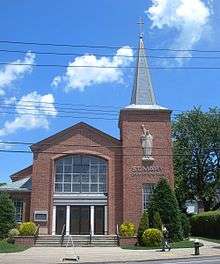
Most businesses are clustered along the central City Island Avenue. There are two small supermarkets, a gas station, a pharmacy, a bank, a hardware store, and a variety of other small shops. The island is most famous for its numerous seafood restaurants and antique stores, which line both sides of the avenue.
At the southernmost section of City Island is Belden Point,[9] named for William Belden, a developer who opened an amusement park and resort in the area in 1887.[10] In the early part of the 20th century, the area was a favored recreation location for business tycoons including Vincent Astor, J.P. Morgan and William Randolph Hearst.[10] Today, Belden Point is home to a number of popular seafood restaurants.[11] A new public greenspace was dedicated in 2016 at its waterfront tip.[12]
Government services include the City Island Station post office (10464) and a FDNY firehouse (Engine 70, Ladder 53). The New York City Police Department presence (mostly traffic control on summer weekends) is provided by the 45th Precinct, located in the mainland Bronx. The City Island Branch is possibly the smallest of the New York Public Library system, even after the recent expansion which doubled the size of the building.
Houses of worship are Saint Mary Star of the Sea Holy Roman Catholic Church, Trinity United Methodist Church, Grace Episcopal Church, and Temple Beth El.
A local paper, The Island Current, is printed ten times a year, and chronicles mostly community issues and local news.[13]
In 1960 City Island became the last community in New York City to get dial telephone service. Until then eight operators in a private home on Schofield Street connected all calls. The dial exchange began as TUlip 5, now 885.
Geology
City Island was created by glacial deposits at the end of the last ice age. There is a layer of bedrock and then a thick layer of red clay topped with sand, with topsoil above that. The southern end has deposits of rare blue clay. The area is strewn with glacial erratic boulders. Local bedrock is Manhattan schist with glacial striations.
Indigenous wildlife
The forms of animal life on the island are not much different from that of the surrounding region, and are typical of a suburban environment: raccoons, squirrels, rabbits, skunk, and occasional deer. Coyotes and turkeys have also been sighted.
The real diversity of wildlife on and around City Island is among birds, especially aquatic species. There are many varieties of duck; buffleheads, goldeneyes, mallards, and cormorants. Canada geese are common, as are mute swans, great blue herons, great white egrets, and several types of gull. A small protected wetlands area on west Ditmars Street is home to many of these species as well as the feral pigeon.
Bright green parrots (monk parakeets), originally imported from South America as pets, have adapted to the climate and breed in the wild in New York. They are a common sight on City Island and in nearby Pelham Bay Park. Flocks of wild turkeys also are often seen in the park. Deer are occasionally seen on the island, although more commonly in Pelham Bay Park. Another, nonnative species of the island is the brown or De Kay's snake, which has adapted to life among the island's growing community.
Activities
Local businesses and attractions
The island is famous for its seafood restaurants; lobster[3] is a popular specialty. Over 30 eating establishments compete for business, ranging from fast food (Johnny's Reef), to The Lobster Box, to the French Bistro SK, and The Black Whale, famous for its desserts.[14] The Snug is an Irish pub connected to the City Island Diner. While a few of the restaurants close during the winter months, most are open year-round.[15]
The City Island Nautical Museum displays maritime artifacts and antiques. It is located at 190 Fordham Street and is open only on Saturday and Sunday afternoons (other times by appointment). Admission is five dollars and there is a small gift shop. The building was PS17 in its prior life.[16]
The Island has landmarks such as the Samuel Pell Mansion on City Island Avenue, near St. Mary Star of the Sea Church. It is where Arsenic and Old Lace (1969) was filmed for TV. There are a number of old Victorian mansions located throughout City Island, mostly on the Sound side, complete with tall pointy spires and gables with gazebos, such as Delmours Point on Tier Street.[17]
The City Island Theater Group is the local community theater that produces shows year round.[18]
City Island Gold Honey is produced by honeybees from the six hive apiary of the Kheck-Gannon family on Minnieford Avenue. It is marketed by the Kaleidoscope Gallery and Sugar And Spice Restaurant.[19]
Boating
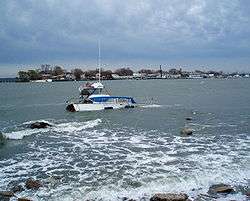
The island has three yacht clubs situated on the Eastchester Bay side of the island. They are, from north to south, the Harlem Yacht Club, the City Island Yacht Club, and the Morris Yacht and Beach Club. The Touring Kayak Club is on the west side of the island. Barron's Boatyard, the North Minneford Yacht Club and the South Minneford Yacht Club are on the east side of the island. There are two active sail lofts (UK-Halsey and Doyle). The island also has several commercial marinas.[20][21][22][23]
The island has what are called "special anchorages" where boats of all sizes are freely moored or anchored, and there are many docks with boat slips for mooring boats in a secure and restricted way. There are also many large piers around the island that can receive large ships.[24]
The island is home to the Columbia University Sailing Team, whose fleet of dinghies is docked at City Island Yacht Club. The team comes from Manhattan four times a week to practice off the western shore of City Island. Fordham University's Sailing Team sails out of Morris Yacht and Beach Club. Many of the boats which competed and won in the America's Cup in years past were built in the Nevins Boat Yard on City Island. The Eastchester Bay Yacht Racing Association is the major organizer for sailboat races in the area. J/24 sailboats are the active one design racing fleet on the island.[25]
A small fleet of head boats takes paying passengers on fishing trips to Long Island Sound. Smaller boats are also available for rent by the day. The sail and power boating industry has been declining in recent years, as boatyards are being sold and being converted into condominiums.[26][27]
Education
City Island is located within the New York City Department of Education.
The School of St. Mary Star of the Sea was a Roman Catholic grade school, serving grades PreK-8 on City Island, until it closed in the end of the 2012-2013 school year.[28] The 175 City Island School, located on City Island Avenue, serves grades K-8 for the island.
The former Public School 17 houses the City Island Historical Society and Nautical Museum. It was listed on the National Register of Historic Places in 1984.[29]
Transportation
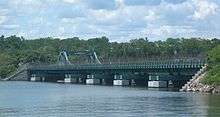
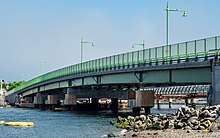
Starting in 1760, a small rope ferry ran between the mainland and City Island. In 1873 a bridge was built by a syndicate of City Island businessmen, including G.W. Horton, Ben Hedgeman, and David Carll. It was replaced by steel, three-lane City Island Bridge in 1901. The New York City Department of Transportation had proposed replacing it with a cable-stayed bridge hanging from a 160-foot tower but the design faced intense community opposition and the city submitted a redesign which was approved.[30] A temporary bridge was used from December 2015 until October 2017 which allowed for the demolition of the old bridge and the construction of its replacement.[31] The New City Island Causeway Bridge opened to traffic on October 29, 2017.[32]
There is another small, private bridge on the northeastern end of City Island connecting it to High Island, site of the radio transmitter for New York stations WFAN (660 AM) and WCBS (880 AM); a security gate prevents public access.
The Pelham Park and City Island Railway connected City Island to Pelham Bay Park from 1887 to 1919. Originally composed of two separate railroads, the 3 ft 6 in (1,067 mm) narrow-gauge horsecar route was operated by the Pelham Park Railroad Company, which ran service between the Bartow station of the Harlem River and Port Chester Railroad and Brown's Hotel on City Island. The 3.2-mile (5.1 km) route was complete by 1892.[33] The Interborough Rapid Transit Company, which operated part of the modern-day New York City Subway, absorbed the two companies in 1902 and started designing its own monorail in 1908.[33][34] The monorail's first journey in July 1910 ended with the monorail toppling on its side.[35][36][34] Although service resumed in November 1910, the monorail went into receivership in December 1911,[37] and the monorail ceased operation on April 3, 1914.[38][39][40] In July 1914, the IRT sold the company to the Third Avenue Railway,[41] which ceased operation of the City Island Railroad on August 9, 1919.[42]
Today, the only public transportation to City Island are two bus routes operated by the Metropolitan Transportation Authority. The island is served by MTA Regional Bus Operations's Bx29 local route, and two rush-hour extended round-trips of the BxM8 express route.[43] The Bronx Tourism Council runs the City Island Seaside Trolley.[44]
In popular culture
Films
- A very early film shot in a City Island studio was Richard III (1912),[45] the oldest surviving American feature-length film.[46]
- The movie City Island (2009), starring Andy García and Julianna Margulies, is set on City Island and was shot there. The film won the Audience Favorite Award at the 2009 Tribeca Film Festival.[47]
- Butterfield 8 starring Elizabeth Taylor
- Long Day's Journey into Night (1962), with Katharine Hepburn
- Awakenings, with Robert De Niro and Robin Williams
- Love Is All There Is, with Lainie Kazan and Angelina Jolie
- A Bronx Tale, with De Niro and Chazz Palminteri, which featured the City Island Bridge and one scene filmed in the parking lot of Johnny's Reef Restaurant.[48]
- Don't Say a Word at the Hart Island Ferry and Hart Island, with Michael Douglas[49]
- Wes Anderson's The Royal Tenenbaums was filmed at Delmours Point, which is the mansion where Long Days Journey into Night was filmed.[17]
- Louis Lombardi shot many scenes from Dough Boys (2008) on the island.
- The Groomsmen (2006), directed by Edward Burns, was filmed at many locations on City Island.[50]
- Margot at the Wedding (2006), starring Nicole Kidman and Ciarán Hinds, which was filmed on City Island Avenue and other locations on the island.
- Michael Douglas returned to City Island with actor Danny DeVito to film Solitary Man (2009) in the City Island Diner.
- Jessica Alba was filmed in An Invisible Sign of My Own (2009) there.
- The documentary film Weiner (2016) includes a scene at a meeting of Democratic party voters on City Island.
Literature
- James Gregory Kingston's novel, The City Island Messenger, uses City Island as the backdrop for a story about a young boy delivering Western Union telegrams that break the sad news of soldiers' deaths to families, over a span of a week during World War II, during the Battle of Midway
- In Kurt Vonnegut's novel Bluebeard, the character Dan Gregory states that his 80-foot (24 m) yacht, the Ararat, was dry-docked on City Island
Production company
- Since 2002, the film production company Harrington Talents has had its offices and studio located on City Island. Notable celebrities who have worked on their productions include rapper and actor Ice-T, and professional wrestler Bruno Sammartino.
Television
Numerous television shows have featured or been shot on City Island. For example:
- Car 54, Where Are You?[51]
- Comedian Jerry Seinfeld visited City Island Diner on the island with Ricky Gervais in one of the webisodes of his Comedians in Cars Getting Coffee[52]
- Coronet Blue
- The Law & Order episode "Maritime" showed the City Island bridge.
- The Law & Order: Criminal Intent episode "Sound Bodies", which was based on a real-life story of several local teenagers who drowned in Long Island Sound near City Island.
- The Law & Order: Special Victims Unit episode "Melancholy Pursuit" partially takes place on City Island.
- The fictional city of Hyde in the series finale of the US version of Life on Mars was filmed on City Island.[53]
Notable residents
Notable current and former residents of the island include:
- Anthony Amato (1920–2011) and Sally Amato (1917–2000), founders and former directors of Amato Opera[54][55]
- Harry Carey (1878–1947), one of silent film's earliest superstars[56]
- Adolfo Carrión Jr. (born 1961), former Bronx Borough President[57]
- Clinton Leupp, drag performer, better known by his drag persona Coco Peru and actor (films To Wong Foo, Thanks for Everything! Julie Newmar and Trick)[58]
- Bruce McRae (1867–1927), silent film actor[59]
- George Meany (1894–1980), union leader who served as president of the AFL-CIO[60]
- Henry B. Nevins (1878–1959), master yacht builder and author
- Vincent Pastore (born 1946), actor known for his portrayal of Salvatore "Big Pussy" Bonpensiero on the TV series The Sopranos[61]
- Carlos D. Ramirez (1946–1999), publisher of El Diario La Prensa[62]
- Red Buttons (1919-2006), comedian-actor who got his start at Ryan's Inn wearing a bellhop uniform with large red buttons.[63]
- Oliver Sacks (1933–2015), who wrote the book Awakenings, whose adaptation was filmed at a house similar to his own, but on a different street on the island[64]
- Salvatore Santoro (1913–2000), Lucchese crime family underboss[65]
- Frank Scalice (1893-1957), Italian-American mobster who led the future Gambino crime family from 1930 to 1931, and was underboss from 1951 to 1957.[66]
- Richard Waring (1911–1994), television and film actor
See also
References
Notes
- ↑ "NYC Planning | Community Profiles". communityprofiles.planning.nyc.gov. New York City Department of City Planning. Retrieved 15 March 2018.
- ↑ "City Island neighborhood in New York". Retrieved 30 October 2015.
- 1 2 3 4 Heelan, Charis Atlas (8 July 2009). "New York's best kept secrets". International Business Times. Retrieved 2009-08-02.
- ↑ DP-1Profile of General Population and Housing Characteristics: 2010 more information2010 Census Summary File 1 for Census Tract 516, Bronx County, New York, United States Census Bureau. Accessed September 24, 2017.
- ↑ History of City Island
- ↑ The 19th Century Ejectment of Henry Piepgras from Land Beneath the Waters Surrounding City Island
- ↑ Clam Digger & Mussel Sucker (City Island terms)
- ↑ In a Seafaring Enclave, Mollusks on the Mind
- ↑ McNamara, John (1993). History in Asphalt: The Origin of Bronx Street and Place Names. Bronx Historical Society. p. 26. ISBN 0-941980-16-2.
- 1 2 "City Island Wetlands". New York City Parks & Recreation. Archived from the original on 4 February 2009. Retrieved 2009-02-01.
- ↑ Pucci, Carol (2002-12-22). "City Island: a touch of Nantucket in New York City". Seattle Times. Retrieved 2009-02-01.
- ↑ Rocchio, Patrick (Aug 5–11, 2016). "Belden Point greenspace dedicated on CI". Bronx Times Reporter.
- ↑ The Island Current
- ↑ Miller, Stuart. "An Oasis for the Locals on Touristy City Island". The New York Times. Retrieved 30 October 2015.
- ↑ "IF YOU'RE THINKING OF LIVING IN; City Island". The New York Times. Retrieved 30 October 2015.
- ↑ "City Island Nautical Museum - History". Retrieved 30 October 2015.
- 1 2 "The Royal Tenenbaums' Summer Home Was In The Bronx". Archived from the original on 23 September 2015. Retrieved 30 October 2015.
- ↑ "Who We Are - City Island Theater Group". Retrieved 30 October 2015.
- ↑ "Artists form 'exotiq' collective". New York Post. Retrieved 30 October 2015.
- ↑ "Stuyvesant Yacht Club Official Website". Retrieved 30 October 2015.
- ↑ "Harlem Yacht Club Official Website". Retrieved 30 October 2015.
- ↑ "City Island Yacht Club Official Website". Retrieved 30 October 2015.
- ↑ "Morris Yacht and Beach Club Official Website". Retrieved 30 October 2015.
- ↑ "Stray Sailboats, and Worries Ashore". The New York Times. Retrieved 30 October 2015.
- ↑ "City Island and the America's Cup". Retrieved 30 October 2015.
- ↑ "A Bit More City on City Island". The New York Times. Retrieved 30 October 2015.
- ↑ Clarkson, Leah. "A Perfect Day on City Island, the Bronx". Archived from the original on 16 August 2015. Retrieved 30 October 2015.
- ↑ Otterman, Sharon. "New York Archdiocese to Close 24 Schools". The New York Times. Retrieved 23 November 2015.
- ↑ National Park Service (2009-03-13). "National Register Information System". National Register of Historic Places. National Park Service.
- ↑ Rocchio, Patrick (April 25, 2014). "Borough President Diaz votes no on City Island Bridge". The Bronx Times. Retrieved April 30, 2014.
- ↑ Rocchio, Patrick (Nov 18, 2015). "City Island temp bridge to open". Bronx Times Reporter.
- ↑ "Mayor de Blasio Announces Opening of New City Island Bridge in the Bronx". The official website of the City of New York. October 29, 2017. Retrieved May 31, 2018.
- 1 2 Editors of the Electric Railway Journal (1907). American Street Railway Investments (PDF). New York: McGraw Publishing Company. p. 217.
- 1 2 John R. Day (1960). More Unusual Railways. London: Frederick Muller Ltd. pp. 100–103.
- ↑ "MONORAIL CAR FAILS IN ITS FIRST TEST; But Electricians and Officials of Pelham Park & City Island Line Say That Was Expected" (PDF). The New York Times. July 8, 1910. Retrieved October 6, 2017.
- ↑ Metcalfe, John (July 16, 2014). "On This Day in 1910, New York's Monorail Suffered a Grievous Wreck". CityLab. Retrieved October 6, 2017.
- ↑ "Receiver for Monorail Line" (PDF). The New York Times. December 13, 1911. Retrieved October 6, 2017.
- ↑ Twomey, Bill (2007). The Bronx, in Bits and Pieces. Rooftop Publishing. p. 39. ISBN 978-1-60008-062-3. Retrieved October 6, 2017.
- ↑ Minutes of the Board of Estimate and Apportionment of the City of New York. M. B. Brown Printing & Binding Company. 1914. p. 2307. Retrieved October 6, 2017.
- ↑ Upham, Ben (2000-11-12). "CITY LORE; The Timetable of Age Overtakes Stations". The New York Times. Retrieved 2017-10-17.
- ↑ "City Island Road Sold" (PDF). The New York Times. July 10, 1914.
- ↑ State of New York Public Service Commission for the First District (1920). Fourteenth Annual Report (PDF). State of New York. p. 398.
- ↑ "Bronx Bus Map" (PDF). Metropolitan Transportation Authority. September 2017. Retrieved April 24, 2018.
- ↑ http://www.ilovethebronx.com/index.php/happenings/bronx-food-and-farm-trolley-tours
- ↑ Richard III filming location
- ↑ "Movie History Emerges from a Basement". The New York Times. Retrieved 30 October 2015.
- ↑ Gootman, Elissa. "A Bronx Island in Many Roles, Even as Itself", The New York Times, March 12, 2010. Accessed March 13, 2010.
- ↑ Travel New York City - Illustrated Guide and Maps. MobileReference ebook. 2010. ISBN 9781605010281.
- ↑ "An Island Of the Dead Fascinates The Living". The New York Times. Retrieved 30 October 2015.
- ↑ The Groomsmen filming locations
- ↑ Car 54, Where Are You? (TV show) filming locations
- ↑ "Mad Man in a Death Machine". Archived from the original on 30 September 2015. Retrieved 30 October 2015.
- ↑ "Canceled Mars Still Filming in NYC"
- ↑ Fox, Margalit. "Anthony Amato, Founder of Amato Opera, Is Dead at 91", The New York Times, December 14, 2011. Accessed September 24, 2017. "Anthony Amato, the founder and artistic director of the Amato Opera Theater, the scrappy, often threadbare and very rarely dull chamber opera company on the Lower East Side of Manhattan that was a mainstay of New York’s cultural life for 61 years, died on Tuesday at his home on City Island, in the Bronx."
- ↑ Kozinn, Allan. "Sally Amato, 82, a Founder Of an Intimate Opera Company", The New York Times, August 18, 2000. Accessed September 24, 2017. "Sally Amato, a singer and actress who founded the Amato Opera with her husband, the conductor Anthony Amato, died on Wednesday at her home in City Island in the Bronx. She was 82."
- ↑ Berger, Meyer. "ABOUT NEW YORK", The New York Times, May 7, 1940. Accessed September 24, 2017. "Harry Carey's description of City Island when he was a boy in the eighties made a hoarse and mildly profane pastorale."
- ↑ Pickert, Kate; and Jame, Randy "Urban Policy Director Adolfo Carrion", Time (magazine), February 20, 2009. Accessed October 15, 2009. "Is 47 and married to a lawyer. They have three daughters and a son and live on City Island in the Bronx."
- ↑ Honia, Stephanie. "New Yorker Spotlight: Drag Queen Coco Peru Reminisces About Her Hometown of City Island in the Bronx", 6sqft.com, December 5, 2014. Accessed September 24, 2017. "Larger-than-life personality and drag queen extraordinaire Coco Peru’s life today couldn’t be much further from her years spent as a child on the quiet streets of City Island.... Coco: I was born in Pelham Bay General hospital in August of 1965 and brought directly home to City Island. I lived there until sometime in the mid-1990s."
- ↑ "HEARING ON THEATRE ENDS.; Federal Trade Board Gets Data In Case of Western Movie Groups.", The New York Times, August 24, 1927. Accessed September 24, 2017. "Bruce McRae, actor, who died at his home at City Island on May 7, left an estate appraised yesterday at $237858 gross..."
- ↑ Today in Labor History Archives Archived 2009-09-11 at the Wayback Machine., BigLabor.com. Accessed October 16, 2009. "August 16: George Meany, plumber, founding AFL-CIO president, born in City Island, Bronx - 1894"
- ↑ Kappstatter, Bob. "Bronx spotlight on Vincent Pastore", Daily News (New York), January 22, 2008. Accessed October 15, 2009. "Vincent Pastore does not sleep with the fishes. He does, however, live close to them, on City Island."
- ↑ Ravo, Nick. "Carlos D. Ramirez, 52, Publisher of El Diario", The New York Times, July 13, 1999. Accessed September 24, 2017. "Carlos D. Ramirez, the publisher of the oldest and one of the largest Spanish-language newspapers in the United States, El Diario/La Prensa, died on Sunday at a hospital in Manhattan. He was 52 and lived on City Island in the Bronx."
- ↑ Rothstein, Mervyn. "Comedian Red Buttons Dies at 87", The New York Times, July 14, 2006. Accessed September 24, 2017. "While attending Evander Childs High School, Aaron got a job as a bellhop and singer at Ryan’s, a bar on City Island in the Bronx, where he got the name Red Buttons: since he wore a bellhop uniform, he was, naturally, called Buttons, and at the time his hair was red."
- ↑ Golden, Tim. "Bronx Doctor Has Best Seller, Hit Movie and No Job", The New York Times, February 16, 1991. Accessed October 15, 2009. "Four white lab coats were known to be somewhere around his red-shingled house on City Island in the Bronx, just not anywhere in particular."
- ↑ Mckelvey, Gerald; and Hurtado, Patricia. "Mob's Commission Is Guilty on All Counts Family Heads Facing Heavy Prisons Terms", Newsday, November 20, 1986. Accessed October 16, 2009. "...underboss Salvatore Santoro, 71, of 90 City Island Ave., Bronx..."
- ↑ Marino, Anthony; and Kline, Sidney. "Albert Anastasia, a Cosa Nostra mobster, is murdered at a barbershop in 1957", New York Daily News, October 26, 1957, republished October 24, 2015. Accessed September 24, 2017. "For some time, Assistant District Attorney Albert Blinder said, his office had been trying to arrange a meeting with Anastasia to discuss the murder of Anastasia's friend, Frank Scalise, last June 17. Scalise, of 211 Kirby St., City Island, Bronx, was shot to death in a fruit store at 2380 Arthur Ave., Bronx, in a still unsolved murder."
Further reading
Maps and charts
Articles
- Transportation from Manhattan
- "Close-up on City Island," Village Voice, 2002
- Forgotten NY
- The City Island Digital Image Gallery
Literature
- City Island & Orchard Beach ( ISBN 0-7385-3546-X)
- The Other Islands Of New York City ( ISBN 0-88150-502-1)
- East Bronx, East Of The Bronx River ( ISBN 0-7385-0301-0)
- Tales of the Clamdiggers ( ISBN 0-9747823-1-9)
External links
| Wikimedia Commons has media related to City Island, Bronx. |
